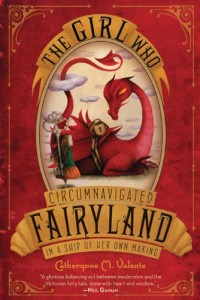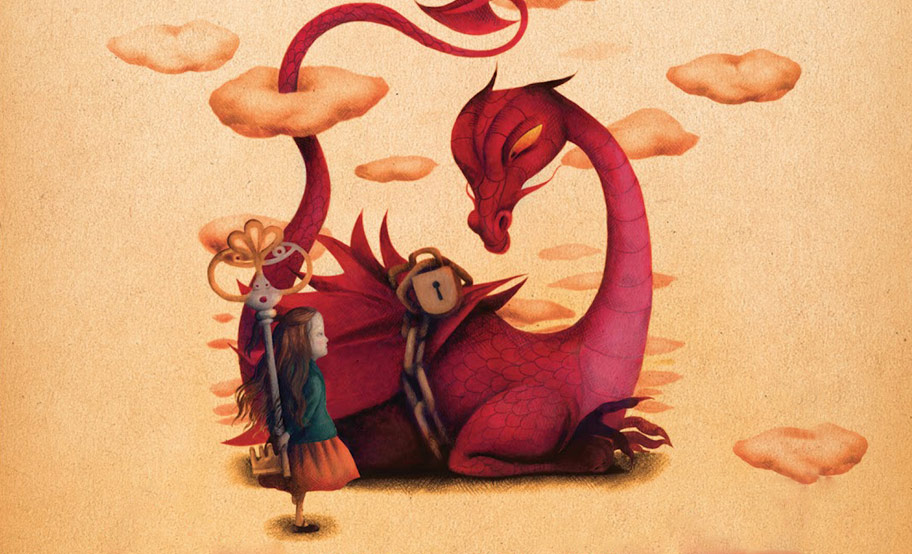
It’s difficult for me, personally, to read portal Fantasy without comparing it against Neil Gaiman’s Stardust, especially those with a fairy tale lilt to its voice. It’s hardly fair to hold one novel against a work of fiction that still, just by evoking its name, transports me, like its protagonist, to another time, another place: a rainy December afternoon, just after Christmas, when I first discovered the beauty of Gaiman’s whimsical imagination. The Girl Who Circumnavigated the World in a Ship of Her Own Making (furthermore, The Girl Who…) has such soul, such a wonderfully commanding and joyous relationship with language, myth and fairy tale, however, that soon after its opening scene, I stopped comparing it against other works, and, in a critic-proof manner that makes this review difficult to write, began to read the work without thought. I fell into its pages, and only crawled out again alongside September, a girl who loses and finds herself in Fairyland.
September read often, and liked it best when words did not pretend to be simple, but put on their full armor and rode out with colors flying.
Though September’s tale is familiar, the telling of it is extraordinary. She is an intelligent girl, though her intellect is often lost behind the naivety of her youth and gets her into as much trouble as it solves. Much of what a reader needs to know about September is summed up in a particular passage that caught my attention:
One ought not to judge her: all children are Heartless. They have not grown a heart yet, which is why they can climb high trees and say shocking things and leap so very high grown-up hearts flutter in terror. Hearts weigh quite a lot. That is why it takes so long to grow one. But, as in their reading and arithmetic and drawing, different children proceed at different speeds. (It is well known that reading quickens the growth of a heart like nothing else.) Some small ones are terrible and fey, Utterly Heartless. Some are dear and sweet and Hardly Heartless At All. September stood very generally in the middle on the day the Green Wind took her, Somewhat Heartless, and Somewhat Grown.
p. 4
She, September, is caught upon a precipice, at twelve years old, of duty and leisure, of the childish world behind her and the world of responsibility that waits ahead. Through the friends she meets, and the challenges she overcomes, she does, by the end of novel, begin to understand that these two worlds, these two sides of her, need not be mutually exclusive, and arriving at this realization alongside her is gratifying and rewards readers who have faced a similar struggle. Her friends, from the Green Wind, the boy Saturday, and the Dragon A-Through-L, are, as companions, as important to September’s journey and self-discovery as she is. Valente’s wonderful creativity and sharp ability to draw life to her characters shines through in each of them.

The first suggestion that the novel is something special comes on the first page. It is not in any extraordinary plot development, or a particularly unusual setting, character or scenario. It’s a love of language that fills every phrase and description.
Once upon a time, a girl named September grew very tired indeed of her parents’ house, where she washed the same pink-and-yellow teacups and matching gravy boats every day, slept on the same embroidered pillow, and played with the same small and amiable dog. Because she had been born in May, and because she had a mole on her left cheek, and because her feet were very large and ungainly, the Green Wind took pity on her and flew to her window one evening just after her twelfth birthday. He was dressed in a green smoking jacket, and a green carriage-driver’s cloak, and green jodhpurs, and green snowshoes. It is very cold above the clouds in the shantytowns where the Six Winds live.
“You seem an ill-tempered and irascible enough child,” said the Green Wind. “How would you like to come away with me and ride upon the Leopard of Little Breezes and be delivered to the great sea, which borders Fairyland? I am afraid I cannot go in, as Harsh Airs are not allowed, but I should be happy to deposit you upon the Perverse and Perilous Sea.”
“Oh, yes!” breathed September, who disapproved deeply of pink-and-yellow teacups and also of small and amiable dogs.
“Well, then, come and sit by me, and do not pull too harshly on my Leopard’s fur, as she bites.”
September climbed out of her kitchen window, leaving a sink full of soapy pink-and-yellow teacups with leaves still clinging to their bottoms in portentous shapes. One of them looked a bit like her father in his long coffee-colored trench coat, gone away over the sea with a rifle and gleaming things on his hat. One of them looked a bit like her mother, bending over a stubborn airplane engine in her work overalls, her arm muscles bulging. One of them looked a bit like a squashed cabbage. The Green Wind held out his hand, snug in a green glove, and September took both his hands and a very deep breath. One of her shoes came loose as she hoisted herself over the sill, and this will be important later, so let us take a moment to bid farewell to her prim little mary jane with its brass buckle as it clatters onto the parquet floor. Good-bye, shoe! September will miss you soon.
pp. 1-2
Enveloping all of this is a sense of wonder and a love for reading and adventure that provides life and passion to every word of every sentence in September’s journey. Like many boys and girls in Fairytales, September leaves her own life because she is bored, and, perhaps, by extension, afraid of growing up into a world that doesn’t appreciate or allow for the whimsical hope and imagination of childhood. The Girl Who… tells the tale of how, through growing friendships with other people just as desperately confused as her, September finds the strength to overcome her uncertainties not in Fairyland, but within herself. September is a voracious reader, and recognizes the themes and lessons that Valente weaves through the story as though the barrier between reader and story doesn’t exist.
It is well known that reading quickens the growth of a heart like nothing else.
It’s said that a lot can be learned from children if you’re willing to take the time to open your eyes and watch them, listen to them. This has certainly been true in my experience. Reading The Girl Who… is much like this. On the surface it appears to be a book written for children, featuring childish things. Open yourself to it, however, and you might just be surprised by how much it teaches you of the adult world. It takes a special author to write so intelligently in a package so simple and rampantly enjoyable.
Pure magic, and should delight readers, children and adult, for decades to come. An instant classic.
As the story unfolds, it begins to feel like Valente is not writing a novel, but pulling back the layers of a story, a fairy tale, that has forever existed, like pulling at a thread that slowly unwinds as a story, having waited for the proper teller. Like Through the Looking Glass before it, The Girl Who… again opens the door to the idea that life is full of wonder and magic, if only you’re willing to open your eyes to it. September learns this lesson, and so, too, does the reader. The Girl Who Circumnavigated Fairyland in a Ship of Her Own Making is pure magic, and should delight readers, children and adult, for decades to come. An instant classic.

I’ve been meaning to read this one. Valente has an incredible style, and a gift for working fairy tales and mythos into fiction. Glad to know it’ll be worth my time.
Beautiful – I am going to read this one!
I read this (and its sequel) aloud to my daughter as a bedtime story, and it was wonderful. I recommend it all the time to people whose children are young enough to still want to be read to sleep but “too old” for picture books. You mention Valente’s love for language, and I think that reading the book aloud is maybe the best way to enjoy her way with words. The sequel, The Girl Who Fell Beneath Fairyland and Led the Revels There doesn’t quite match the sheer delightful beauty of this book, but in it September has to deal with some of the consequences of her first trip to Fairyland, which is a powerful idea on its own. I can’t wait to get my hands on the third book in the series this autumn.